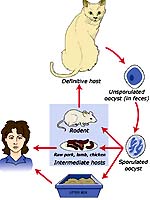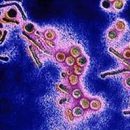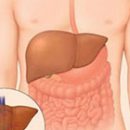Toxoplasm - a unicellular parasite living in the body of many mammals and man. By approximate estimates, each fourth resident of the Earth is infected. In most cases, toxoplasmosis proceeds asymptomatic, but people with weakened immunity it can lead to dangerous complications.
Content
The causative agent of toxoplasmosis
Toxoplasmosis - a disease, the pathogen of which does not apply to any viruses or bacteria. Causes it toxoplasm - widespread in nature «the beast», Representative of the simplest type.
 Awareness of the population about who are the simplest, is exhausted, as a rule, information obtained in high school. The harmless and entertaining infusorian-shoe - simple, nicely shelters with cilias and does not cause anything but sympathy (especially if you do not need to explain to the teacher that it is inside).
Awareness of the population about who are the simplest, is exhausted, as a rule, information obtained in high school. The harmless and entertaining infusorian-shoe - simple, nicely shelters with cilias and does not cause anything but sympathy (especially if you do not need to explain to the teacher that it is inside).
Toxoplasm, under a microscope, also quite cute, reminds, however, not a shoe, but an orange slice, but on this all positive comparisons end. In Latin, it is called toxoplasma gondii - in honor of the living either in Tunisia, or in Algeria Rodent Gondi, whose toxoplasm was first discovered as much as in 1908.
Since that time, it was possible to learn about the toxoplasm almost everything - how to multiply how infection is transmitted as a disease develops. Known symptoms, methods of treatment and prevention. But the patients with toxoplasmosis do not become less - maybe because they own a very few information. Let's join the narrow circle of dedicated.
Toxoplasm can multiply in two ways - sex and sex. In both cases, several intermediate forms are formed, and each form has its own name. These names, even pronounce terrible - involuntarily creates the impression that their (these names) were specifically invented for bullying the doctors of the doctors, which are sad, twitch the limbs and fall into depression when only one thought is that at the microbiology exam «Toxoplasmosis».
Do not believe - see for yourself. Only two quotes from the microbiology textbook:
«…Part of the parasites penetrates into the epithelial cells of the intestine, where the process of schizogonia occurs with the formation of 4-30 merozoites. After several reproduction cycles, microgamecates and macrogamecites are formed, as a result of the merger of which the oocyst is formed».
«Inside the Oocysts there are two sporocists with four disposer. In the process of multiple division, measurement arise…»
And in the textbook they write about trophozoites, tachiesoites and bradyzoites.
Well, how? I think comments are superfluous - that's the simplest!
Ways of breeding toxoplasm
Why is it all important to know that there are two ways to breed?
The fact is that, multiplying in the intestine in sexual means, the toxoplasms form cysts, very resistant to the factors of the external environment. Leaving the intestine, they have long retained vitality, are not afraid of drying, low and high temperatures and, as a result, are the source of infection of other organisms. If the reproduction is punishable - the disease occurs, but «affected» Practically not contagious for others (sustainable cysts are not formed).
Toxoplasmosis is sick with many animals - both wild and home. Dogs, cats, rabbits, monkeys, pigs, mice, horses, chickens, pigeons and t. D. - Total about 300 species of mammals and 60 species of birds. Man is also ill. But!!! Sexual reproduction of toxoplasm occurs only in the intestine of cats and other representatives of the Feline family.
This is very important precisely because, hawned toxoplasmosis, neither a man nor a dog, nor the chicken, nor the guinea pig are infectious. In short, toxoplasmosis is an individual problem of a particular individual. This individual can not literally have a feder (t. E. Cannibalism: Meat - Source of infection), but everything else with it (this individual) can be done: kissing, hugging, there is from one plate, to enter into sexual contact, and the probability to get toxoplasmosis is almost equal to zero. It's not worth the blood from it to overflow and replant organs - although in this case «pick up» The disease is very problematic.
And only the cat is a cute, fluffy, tender and charming - is a potential source and main distributor of infection. And if the child play in the knobbed sandbox, toxoplasmosis (DITY) is guaranteed by almost 100% guaranteed. And if your meowing favorite at least sometimes leaves the walls of the apartment, if it is at least occasionally eats raw meat, - it has toxoplasmosis with the maximum possible degree of probability.
Information for reflection: for 15-20 days of illness, one cat highlights about 2 billion cysts into an external environment, which retain their infinity up to two years!
Ways of infection toxoplasmosis
To get the toxoplasmosis can be dispersed with meat, for example, infected rabbit, lamb, pigs and t. D. Meat, of course, should be raw, for the slightest thermal processing toxoplasm kills. People are infrequently eating raw meat, but licking the cattle minced language - the thing is familiar to many housewives. And as a result - no cats and there was no, and toxoplasmosis is present.
 Another way of infection is the use of unwashed vegetables and fruits: in the gardens and gardens, as you know, a lot of representatives of the glorious Feline family are found.
Another way of infection is the use of unwashed vegetables and fruits: in the gardens and gardens, as you know, a lot of representatives of the glorious Feline family are found.
Immediately stopping! No need to drive out a cat from home! No need to pull the baby from the sandbox! No need to wipe apples with alcohol!
Let's understand Next.
Taking into account the ease of infection (and cats, and the unwashed fruit-vegetables in our lives, it is plentifully) not to meet with toxoplasm during the life is very difficult, but because the patients around us are not very much and a lot. So it turns out that actually toxoplasmosis is not so terrible, as it may seem at first glance.
The fact is that the body of a normal person - whether it is an adult or a child - quite easily copes with toxoplasmas. After entering the parasite to the gastrointestinal tract there is a complex response, but the result is almost always predetermined - the production of antibodies, neutralizing toxoplasms, and the formation of persistent (for the rest of the rest) immunity.
It is interesting that even the most first infection, accompanied by a rather substantial reaction of the immune system, as a rule, does not lead to any symptoms - a person feels completely healthy and actually so it is.
Logical conclusion: Toxoplasmosis is not any significant problem only at one, but mandatory condition - the presence of a person full-fledged immunity. It is not surprising that in patients, for example, AIDS toxoplasmosis in infection develops almost always. Peeling peacefully in the body of the toxoplasm can be activated and cause severe illness against the background of any actions (irradiation, the use of depressing immunity of drugs) or diseases (herpetic infection, cytomegalovirus infection, infectious mononucleosis, and T. NS.) leading to a decrease in immunity.
I would like to draw attention to the fact that for the occurrence of toxoplasmosis, the decrease in immunity should be quite significant. If the child regularly run snot if the doctor «not really like blood test», If after another ORZ managed «earn» inflammation of the lungs and t. NS. - This is not a reason to kill, panic and communicate with a cat exclusively in gloves and gas mask.
Again, if a person is diagnosed with toxoplasmosis - not just detected toxoplasm or antibodies to it, and there are specific symptoms of the disease, it should always be sent certain efforts to search for a causal factor, which led to such a pronounced decrease in the body's immune protection. It is not surprising that the detected toxoplasmosis is a serious and obligatory basis for a thorough examination primarily on HIV infection (human immunodeficiency virus - AIDS causative agent).
Since we mentioned the symptoms of the disease, we note that they are not specific (except eye damage). T. E. There is no specific clinical feature that allows you to diagnose precisely toxoplasmosis with confidence. Toxoplasm with blood current is distributed from the intestine and in lymph nodes, and in the internal organs, it strikes the nervous system - it is clear that the symptoms can be the most diverse.
Most often symptomatics is limited to a small increase in lymph nodes (usually cervical). There may be an increase in body temperature, an increase in liver and spleen, pharyngitis. In more severe cases, inflammation of the lungs is developing, the brain is affected (encephalitis), the inner sheath of the heart (endocarditis) is affected, possibly a specific lesion of the organ of vision - inflammation of the retina and the vascular shell of the eye (toxoplasmable chorioretinite) and (or) inflammation of the vascular shell of the eyeball (toxoplasmatic will avy ).
With a significant decrease in the immunity of the manifestation of the disease, very serious - most often developing a very serious lesion of the brain (necrotizing encephalitis), not uncommon endocarditis and pneumonia.









